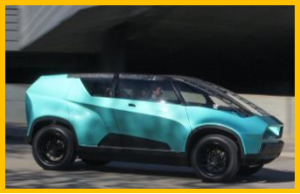 Most of Toyota’s North American vehicles are engineered in Southeast Michigan so it’s no surprise the world’s largest automaker uveiled a concept car that targets Gen Z at the SAE world congress late this morning. Designed, engineered and hand-built by graduate students at Clemson University’s International Center for Automotive Research, or CU-ICAR, uBox is the result of a two-year collaboration with Toyota Motor North America designers and engineers.
Most of Toyota’s North American vehicles are engineered in Southeast Michigan so it’s no surprise the world’s largest automaker uveiled a concept car that targets Gen Z at the SAE world congress late this morning. Designed, engineered and hand-built by graduate students at Clemson University’s International Center for Automotive Research, or CU-ICAR, uBox is the result of a two-year collaboration with Toyota Motor North America designers and engineers.
The Art Center College of Design in Pasadena also worked on the project The result is a concept car that attempts to appeal to the next generation of car buyers – Gen-Z.
 The collaboration, called Deep Orange, immerses students into every aspect of automotive development – from market research and design studies to engineering design and manufacturing. This is the sixth Deep Orange concept, and it likely started out as a Scion, before the brand’s demise last February.*
The collaboration, called Deep Orange, immerses students into every aspect of automotive development – from market research and design studies to engineering design and manufacturing. This is the sixth Deep Orange concept, and it likely started out as a Scion, before the brand’s demise last February.*
“Deep Orange gives students’ hands-on experience with the entire vehicle development process, from identifying the market opportunity through the vehicle build,” says Johnell Brooks, an associate professor in Clemson’s graduate engineering program. “It’s like automotive boot camp for the real world, and it wouldn’t happen without industry partners like Toyota.”
The typical customer for uBox is described as a young entrepreneur who wants a vehicle that can provide utility and recreation on the weekend but that can also offer office space or lifestyle uses during the week.
Some of the aspects of uBox include:
- A distinctive exterior design that allegedly supports generation Z’s want to stand out.
- A versatile interior that can be rearranged for various activities, from working or operating a business, to hauling bulky cargo. A low floor allows for re-configurable, removable seats on sliding tracks that can be nested.
- Vents, dashboard display bezels and door trim that can be personalized and made with 3-D printing technology, and an online community for owners where they can share design ideas.
- A compact, dual-purpose, all-electric powertrain providing emission-free stationary energy to power consumer electronics, power tools or other devices through various 110-volt sockets located throughout the interior and exterior.
One thing that caught the attention of Toyota Executive Program Manager Craig Payne; a unique “pultrusion” technique developed by the students that allows composite carbon fiber rails bonded with aluminum to support a curved glass roof.
“The roof pultrusion was something unexpected and very interesting when they first started talking about the concept” said Payne. “The fact that they were able to achieve an industry-first manufacturing technique as students speaks volumes for this program.”

